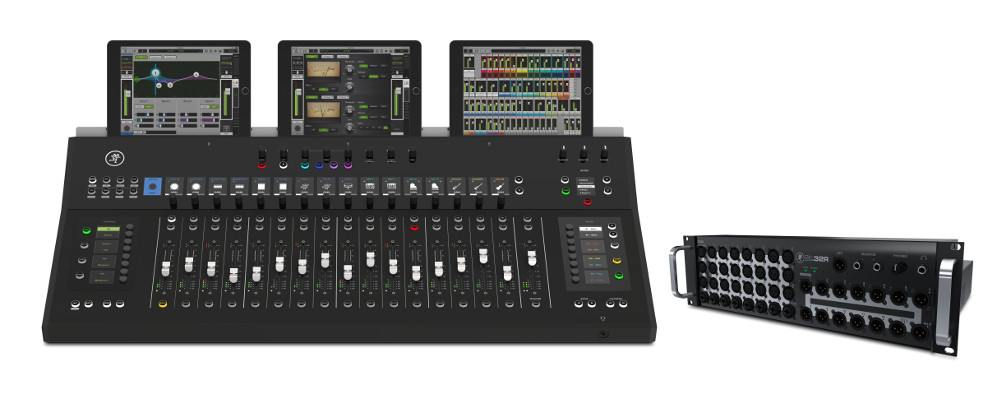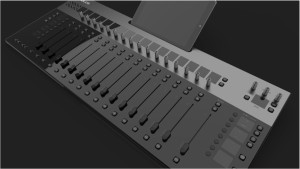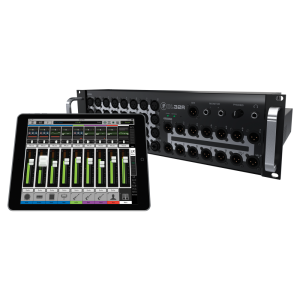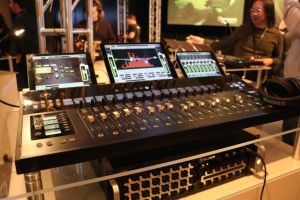Research & Development: Mackie AXIS Digital Mixing System
Mackie’s engineering team had a tantalizing challenge staring them in face: Create a system for live sound designed to seamlessly combine wireless mixing with hardware controls.
That called for designing a hardware control surface that would converge seamlessly with their popular DL32R 32-Channel Rackmount Digital Mixer and Master Fader control app – and give birth to something even bigger and badder in the process.
The result is new Mackie AXIS Digital Mixing System. It captured our attention instantly when we saw it at Winter NAMM, pairing the DL32R with the striking new DC16 Digital Control Surface.
On the surface, the AXIS’ immense visual feedback grabs eyes with large, high-resolution screens and the ability to use up to three iPads via Mackie’s SmartBridge design. Under the hood, AXIS features flexible 32×32 recording, a wide selection of powerful DSP, and full Dante audio networking protocol interoperability, for a massively flexible modular mix experience.
Together, Mackie’s Ben Olswang, Senior Product Manager; Kent Swendseid, Director of Industrial Design; and Graham Jordan, Digital Engineer Manager and their team were taking on a big opportunity with live mixers: To better inform ergonomics, creative and sonic possibilities, while providing the essential capabilities of wireless mixing in the process.
Even better, they explained their decisions along the way to SonicScoop. To see why live sound is the arena where audio technology and cross-platform integration is accelerating the fastest, read on about AXIS.

Wireless mixing, modular design, visual advances, and the iPad: Mackie’s AXIS Digital Mixing System shows how live audio is pulling together the latest in audio developments.
Starting from the 10,000-ft. view, how does Mackie decide what new products – hardware and/or software – to develop?
Ben: All new products start with the user: Who is it for? What are they trying to achieve? What are the problems they encounter when using the currently available gear?
If we don’t think we can make a meaningful improvement to the user, we keep looking. We do this by watching and asking a lot of questions. Of course we’re all engineers and use the gear ourselves, but it is incredibly important for us to talk to customers, watch them work and listen to what they have to say.
What did you hear from those users that made development of the AXIS Digital Mixing System a priority for Mackie?
We learned that many of the digital mixing systems out there were delivering lots of features, but making them difficult to use and slower to mix on. We also learned engineers are incredibly diverse, each with their own desired workflow that often changes depending on the event.
So, we wanted to make a system that was incredibly intuitive and focused on allowing the user to mix as quickly as possible. We improved their workflow through increased visibility and customization, allowing them to configure the console as needed for a particular show.
How do you see the needs of live mixing professionals changing, from an ergonomic, creative and sonic standpoint?

AXIS early concept design
Kent: Live mixing professionals are still concerned about the same things they’ve always been concerned about. However, digital technology allows a conceptual shift from the paradigms of the analog realm into newer and evolving models of human hardware interaction that will inform ergonomics, creative and sonic possibilities.
The ability for an engineer to make changes from anywhere is especially powerful. Any engineer that embraces wireless mixing never looks back. We wanted to design a mixing system that incorporated wireless mixing from the beginning.
How did this evolution lead to the initial vision for AXIS – what did you see as the big technical opportunities that would result from a modular system such as this, that integrates the Mackie DL32R digital mixer with the DC16 control surface?
Ben: Modular systems deliver incredible benefits to the user. Most importantly it allows them to place the I/O at the most opportune location for patching while placing the control surface at FOH or MON as needed. This removes the need for an analog snake, as you can simply patch directly to the I/O on stage. Eliminating an analog snake removes a large expense and improves audio quality, as you have none of the sonic degradation inherent with long analog audio runs over copper.
And by utilizing Dante as our digital audio network, it opens up our system to integrate easily with the hundreds of other Dante products available, giving the user the flexibility to route audio digitally between all their Dante devices.
Another benefit of our modular implementation is based on where we put the DSP processing. Many modular systems put the DSP in the control surface, which turns the I/O into a simple digital snake. We chose to instead put the processing in the I/O and make our control surface a controller with some local I/O. This allows the user to use the system without the control surface if desired.
This provides incredible flexibility for production companies as they can size their system as needed for a particular event. For example, if they are running a festival, they can take the full AXIS system (DL32R mixer and DC16 control surface). But for a corporate event where the client would prefer to not have a FOH for aesthetic reasons, they can simply bring the DL32R and mix wirelessly from the audience. This gives them more utility than a standard all-in-one mixer or conventional modular system can provide.
Conversely, what did you identify as the most significant challenges you would face in realizing that vision?
Graham: Designing the DC16 and AXIS system as a whole for the required functionality was a big challenge; from the hardware architecture using multiple processors, to the distributed nature of the software in the system.

The Mackie Master Fader iPad app was already adept with the DL32R rackmount digital mixer.
Making the controls and displays on the DC16 work seamlessly with the Master Fader control app, so the user can work effectively with both simultaneously, took a lot of work. In order for the control surface to efficiently handle so many screens and faders, plus direct iPad connection, required partitioning the work across multiple processors to meet user interface response and functional requirements. The design and implementation of the firmware required was a significant challenge, with the opportunity to take user experience to a higher level.
The AXIS SmartBridge design allows for unique customization of iPad views, including a “follow” feature where the screens follow you as you work, so the last few adjusted channels are always visible for quick adjustment.
This feature is amazing, and was a great opportunity to do something original — yet it required a lot of effort and iterations to work as we wanted. It’s a feature where there’s a lot going on “under the hood” to make it simple for the user.
Please describe the major stages of the design process – what had to happen in order for the AXIS system to move from concept to prototype to finished product?
Kent: The initial research phase starts with data gathering where we investigate the market, the users, new technology and set the foundation of the problem we need to solve.
In this case, the problem or opportunity was the creation of a hardware control surface that would pair with the DL32R and the Master Fader control app. That is to say we approached the next phase philosophically looking at the DL32R, Master Fader, and control surface as a system that, when combined together, would be greater than the sum of the respective parts.
Concept development is always the fun part where we get to dream and create solutions that address the problem defined in the research phase. We iterate quickly and very often in order to investigate the myriad of possible solutions. One thing that came out of our initial Industrial Design concepts was the idea of using multiple iPads with the surface in order to increase visual feedback and create a faster workflow.
The concept refinement phase is where a lot of the hard decisions get made as we evaluate and ultimately prototype for validation. One of the critical areas was the SmartBridge and how to securely hold the iPads, while remaining compact and retaining great ergonomics. We needed the iPads to be easily accessible while at the same time feeling secure, all without sacrificing the compact nature of the control surface.
Once the prototype had been validated, we moved into design for manufacturing, where the hurdles of manufacturing processes can make life interesting and challenging for our engineers.
Of all those stages, did one turn out to be the most complex to complete?
Kent: The hardest stage is always taking the conceptual models into production. There are numerous constraints ranging from electronic component layouts, Industrial Design intent, mechanical limitations, manufacturing processes, thermal dissipation, and electronic compliance that can make production a challenge.
On that note, what were some surprises along the way that you learned about human interface design, specifically, as you built the AXIS?
Ben: One of our goals was to ensure the AXIS System gave the user the best visual feedback experience of any digital mixing system, which ultimately gives the user an intuitive and faster workflow.

All lit up in real life — AXIS on display for its debut at Winter NAMM 2016,
We spent a lot of time learning about text size, researching things like legibility indices that are normally outside the world of pro audio. We repeatedly tweaked the design and layout to make every aspect of the display extremely legible.
Having full- color channel ID screens that show channel names, colors and icons, really does help the operator identify channels quickly. Each person uses a range of different cues to recognize things and having all three allows different individuals to all have the benefit.
Who do you see as being early adopters of the AXIS? And what type user do you think will need some convincing?
Ben: We have tons of pros using our DL1608 and DL32R for small- to medium-sized gigs and they truly understand the value wireless mixing brings to their workflow.
However, many of these users have told us that they need physical controls for some of their larger projects. The AXIS system was designed to seamlessly combine wireless mixing with hardware controls. Users who see the value in both will definitely be excited about AXIS.
I take it you’re getting plenty of feedback from new users, trade shows and private demos. How are you deciding what feedback to incorporate ASAP into the next version, versus putting on the list to do later?
Ben: Prioritizing feature requests is always a welcome challenge. After all, who better to guide features and functionality than users? We have to look at everything and decide which feature additions will have the most impact to the most users.
We also need, of course, to look at our engineering plans to make changes as efficient as possible. That’s one of the benefits of Mackie’s dedication to creating a tightly integrated hardware/software platform. We can (and do) upgrade the Master Fader software often, adding functionality.
With other digital consoles, this would feel like a simple add-on feature for a companion app that already feels a bit disconnected. Since AXIS and Master Fader are integrated so perfectly, changes to Master Fader drive functional improvements in the total mix experience. We always watch, talk and learn from user, so we can iterate into better implementation.
Thank you gentlemen! Lastly, what’s The Big Lesson you learned from the process of creating the AXIS system – put another way, what advice would you give to someone thinking of designing an ambitious live mixing system?
Ben: Ask a lot of questions and don’t assume anything.
— David Weiss
Please note: When you buy products through links on this page, we may earn an affiliate commission.






